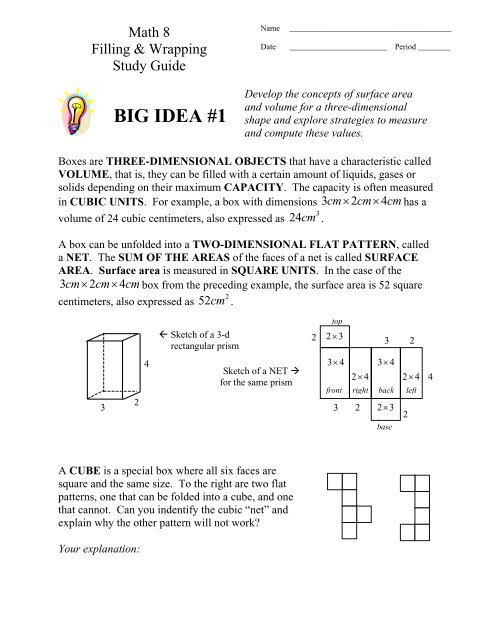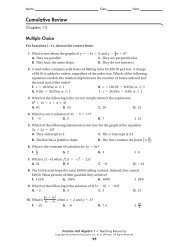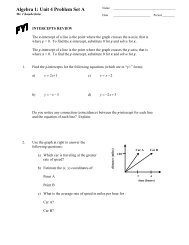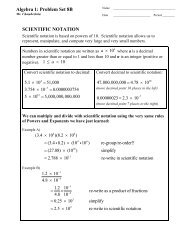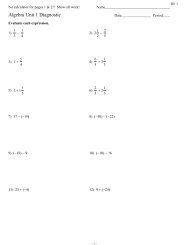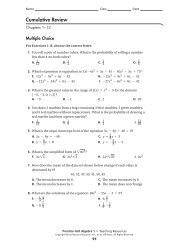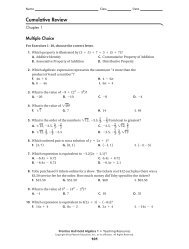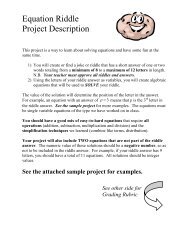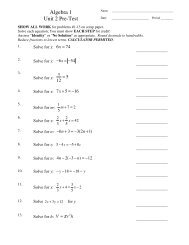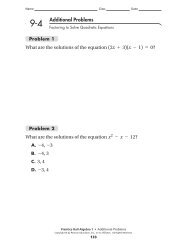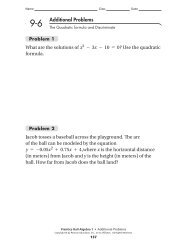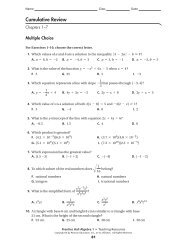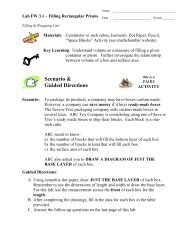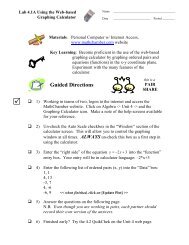Unit Test Study Guide - MathChamber
Unit Test Study Guide - MathChamber
Unit Test Study Guide - MathChamber
You also want an ePaper? Increase the reach of your titles
YUMPU automatically turns print PDFs into web optimized ePapers that Google loves.
Math 8<br />
Filling & Wrapping<br />
<strong>Study</strong> <strong>Guide</strong><br />
Name<br />
Date<br />
________________________________________<br />
________________________ Period ________<br />
BIG IDEA #1<br />
Develop the concepts of surface area<br />
and volume for a three-dimensional<br />
shape and explore strategies to measure<br />
and compute these values.<br />
Boxes are THREE-DIMENSIONAL OBJECTS that have a characteristic called<br />
VOLUME, that is, they can be filled with a certain amount of liquids, gases or<br />
solids depending on their maximum CAPACITY. The capacity is often measured<br />
in CUBIC UNITS. For example, a box with dimensions 3cm× 2cm× 4cm<br />
has a<br />
3<br />
volume of 24 cubic centimeters, also expressed as 24cm .<br />
A box can be unfolded into a TWO-DIMENSIONAL FLAT PATTERN, called<br />
a NET. The SUM OF THE AREAS of the faces of a net is called SURFACE<br />
AREA. Surface area is measured in SQUARE UNITS. In the case of the<br />
3cm× 2cm×<br />
4cm<br />
box from the preceding example, the surface area is 52 square<br />
2<br />
centimeters, also expressed as 52cm .<br />
Sketch of a 3-d<br />
rectangular prism<br />
2<br />
top<br />
2×<br />
3<br />
3<br />
2<br />
3<br />
2<br />
4<br />
Sketch of a NET <br />
for the same prism<br />
3× 4 3×<br />
4<br />
2× 4 2×<br />
4<br />
front right back left<br />
3<br />
2<br />
2×<br />
3<br />
base<br />
2<br />
4<br />
A CUBE is a special box where all six faces are<br />
square and the same size. To the right are two flat<br />
patterns, one that can be folded into a cube, and one<br />
that cannot. Can you indentify the cubic “net” and<br />
explain why the other pattern will not work<br />
Your explanation:
Vocabulary you should know:<br />
1. cone<br />
2. cube<br />
3. cylinder<br />
4. edge<br />
5. face<br />
6. flat pattern<br />
7. prism<br />
8. surface area<br />
9. radius<br />
10. volume<br />
A 3-D shape with a circular end and a<br />
pointed end.<br />
A 3-D shape with six IDENTICAL<br />
square faces.<br />
A 3-D shape with two opposite faces<br />
that are congruent circles. A<br />
rectangle (the side wall) is wrapped<br />
around the circular ends.<br />
The line segment formed where two<br />
faces of a 3-D shape meet.<br />
A polygon that forms one of the flat<br />
surfaces of a 3-D shape.<br />
An arrangement of attached polygons<br />
that can be folded into a 3-D shape.<br />
A 3-D shape with a top and a bottom<br />
that are congruent polygons and<br />
faces that are parallelograms.<br />
The area required to cover a 3-D<br />
shape. In a prism, it is the sum of all of<br />
the areas of all of the surfaces.<br />
The distance from the center of a circle<br />
to any point on the circle.<br />
The amount of space, or the capacity,<br />
of a 3-D shape. It is the number of unit<br />
cubes that will fill a 3-D shape.
BIG IDEA #2<br />
Understand the concept that a box is<br />
more EFFICIENT if it can hold the<br />
same volume using less surface area (or<br />
packaging material).<br />
Rectangular prisms with different shapes can hold the same volume. Draw the<br />
prisms specified below and compute their respective surface areas.<br />
Prism A<br />
Dimensions: 1 × 1 × 12<br />
Prism B<br />
Dimensions: 1 × 2 × 6<br />
Prism C<br />
Dimensions: 2 × 2 × 3<br />
Front:<br />
Back:<br />
Top:<br />
Base:<br />
Left:<br />
Right:<br />
2<br />
___ × ___ = ____ cm Front:<br />
2<br />
___ × ___ = ____ cm Back:<br />
2<br />
___ × ___ = ____ cm Top:<br />
2<br />
___ × ___ = ____ cm Base:<br />
2<br />
___ × ___ = ____ cm Left:<br />
2<br />
___ × ___ = ____ cm Right:<br />
2<br />
___ × ___ = ____ cm Front:<br />
2<br />
___ × ___ = ____ cm Back:<br />
2<br />
___ × ___ = ____ cm Top:<br />
2<br />
___ × ___ = ____ cm Base:<br />
2<br />
___ × ___ = ____ cm Left:<br />
2<br />
___ × ___ = ____ cm Right:<br />
2<br />
___ × ___ = ____ cm<br />
2<br />
___ × ___ = ____ cm<br />
2<br />
___ × ___ = ____ cm<br />
2<br />
___ × ___ = ____ cm<br />
2<br />
___ × ___ = ____ cm<br />
2<br />
___ × ___ = ____ cm<br />
2<br />
2<br />
SURFACE AREA = ____ cm SURFACE AREA = ____ cm SURFACE AREA<br />
2<br />
= ____ cm
BIG IDEA #3<br />
Using formulas is most effective when<br />
you have a structured approach. Lab 5.1<br />
(Vorple-Norple) detailed a structured<br />
top-down method for using formulas.<br />
Use the method detailed<br />
in the example at right to<br />
maximize your success<br />
when working with<br />
formulas.<br />
Steps to calculate the PLOMP of a VORPLE:<br />
(Write the generic formula)<br />
P = u+ 2( b−w) (Substitute the values for b, w, and u)<br />
= 4 + 2(9 −3) (Parentheses first)<br />
= 4 + 2(6) (Multiplication before addition)<br />
= 4 + 12 (Last step: addition)<br />
P = 16<br />
BIG IDEA #4<br />
To find the volume of any right prism or<br />
cylinder, first find the AREA OF THE<br />
BASE, then MULTIPLY BY THE<br />
HEIGHT.<br />
See your work in Labs 3.3 and 4.1B for examples.<br />
BIG IDEA #5<br />
Understand the relationship of the<br />
volumes of CONES and SPHERES to<br />
cylinders of the same radius and height.<br />
See your work in Lab 5.2 for examples.<br />
NOW, it’s time to PREPARE for the Filling & Wrapping UNIT TEST.<br />
Work on the problems supplied in this packet. Draw pictures as required and<br />
SHOW ALL WORK. Got questions Speak up in class or get on the BLOG!
1. A cylinder has a volume of 120cm 3 . What is the volume of a cone with the same<br />
radius and height<br />
2.<br />
On the square dot paper at<br />
right, draw the:<br />
a) top view<br />
b) front view<br />
c) right side view<br />
of the 3-D object pictured<br />
below:<br />
.<br />
d) What is the surface area of the 3-D object above (assume square centimeters)<br />
3. Write the volume formulas for a cylinder and a cone. Explain the relationship<br />
(compare & contrast). If you find it helpful, draw a picture.
4. a) Draw a rectangular prism with the following l x w x h dimensions: 2 x 3 x 8.<br />
b) Calculate the Volume (show all work):<br />
c) Calculate the Surface Area (show all work):<br />
d) Give the dimensions of another box that would hold the same volume but has<br />
less surface area:<br />
e) Give the dimensions of another box that would hold the same volume but has a<br />
greater surface area:
5. A cylinder has a radius of 6 inches and a height of 10 inches.<br />
Sketch a generic drawing (not to scale) and label a picture of the cylinder.<br />
a) Sketch<br />
b) Calculate the Volume<br />
6. Find the volume of the triangular prism pictured below:<br />
12<br />
8<br />
20
7. a) What is the volume of the rectangular box pictured below<br />
10 cm<br />
6 cm<br />
5 cm<br />
b) Identify possible dimensions for a rectangular box with twice the volume:<br />
c) A box with one-tenth the volume of the box in #17 (above) has a<br />
height of 2 centimeters. Identify possible dimensions of this box.<br />
Draw this box on the isometric dot paper below.
Find the volumes of the containers below. SHOW ALL WORK!<br />
(round decimals to hundredths)<br />
All units in centimeters (figures not drawn to scale)<br />
8)<br />
12<br />
12<br />
12<br />
22<br />
8<br />
12<br />
12<br />
12<br />
9)<br />
r = 7<br />
18<br />
10)<br />
r = 12.3<br />
15.4


